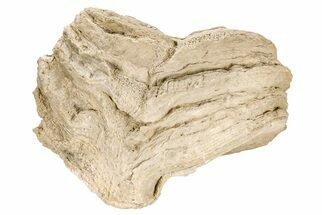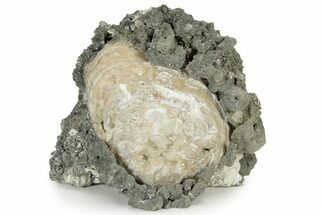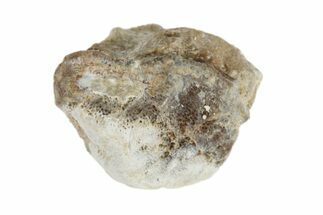This Specimen has been sold.
4.6" Fossil Cretaceous Rudist (Durania) - Kansas
This is a 4.6" long fossil rudist of the species Durania maxima. It comes from the Late Cretaceous, Smoky Hill Chalk in Gove County, Kansas.
A rudist is a ring-shaped marine heterodont bivalve that arose during the Late Jurassic and died out near the end of the Cretaceous. Durania maxima rudists had heavy cone shaped shells, often with a large, circular collar, and is typically found in the lower 1/3 of the Smoky Hill Chalk.
The Smoky Hill Chalk Member of the Niobrara Chalk formation is a Cretaceous conservation Lagerstätte, or fossil rich geological formation, known primarily for its exceptionally well-preserved marine reptiles. It outcrops in parts of northwest Kansas, its most famous localities for fossils, and in southeastern Nebraska. Large well-known fossils excavated from the Smoky Hill Chalk include marine reptiles such as plesiosaurs, large bony fish such as Xiphactinus, mosasaurs, flying reptiles or pterosaurs (namely Pteranodon), flightless marine birds such as Hesperornis, and turtles. Many of the most well-known specimens of the marine reptiles were collected by dinosaur hunter Charles H. Sternberg and his son George.
A rudist is a ring-shaped marine heterodont bivalve that arose during the Late Jurassic and died out near the end of the Cretaceous. Durania maxima rudists had heavy cone shaped shells, often with a large, circular collar, and is typically found in the lower 1/3 of the Smoky Hill Chalk.
The Smoky Hill Chalk Member of the Niobrara Chalk formation is a Cretaceous conservation Lagerstätte, or fossil rich geological formation, known primarily for its exceptionally well-preserved marine reptiles. It outcrops in parts of northwest Kansas, its most famous localities for fossils, and in southeastern Nebraska. Large well-known fossils excavated from the Smoky Hill Chalk include marine reptiles such as plesiosaurs, large bony fish such as Xiphactinus, mosasaurs, flying reptiles or pterosaurs (namely Pteranodon), flightless marine birds such as Hesperornis, and turtles. Many of the most well-known specimens of the marine reptiles were collected by dinosaur hunter Charles H. Sternberg and his son George.
SPECIES
Durania maxima
LOCATION
Gove County, Kansas
FORMATION
Niobrara Formation
SIZE
4.6" long, 4.6" wide
CATEGORY
ITEM
#96405
We guarantee the authenticity of all of our
specimens. Read more about our
Authenticity Guarantee.
specimens. Read more about our
Authenticity Guarantee.
 Reviews
Reviews













